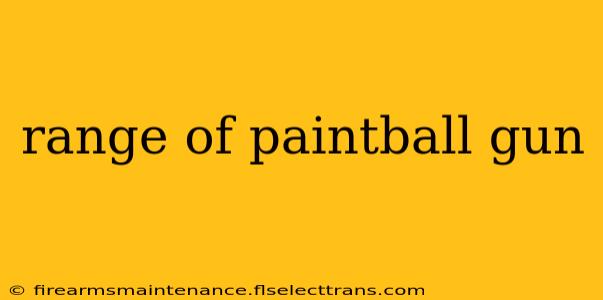Paintball is a thrilling sport that combines strategy, teamwork, and precision. A key element influencing success in paintball is understanding the range of your paintball gun. However, the "range" isn't a single, fixed number. It's a complex interplay of several factors affecting both the maximum distance a paintball can travel and the accuracy at that distance. Let's break down the key variables:
Factors Affecting Paintball Gun Range
Several factors contribute to the effective range of a paintball marker:
1. Paintball Gun Type and Model:
Different paintball markers are designed with varying capabilities. High-end tournament markers often boast greater accuracy and range due to their superior internal components and design. Conversely, entry-level markers may have shorter effective ranges and less consistent accuracy. The type of marker—mechanical, semi-automatic, or fully automatic—also plays a role, though generally, this impacts rate of fire more than maximum range.
2. Paintball Quality and Type:
The paintball itself is crucial. A poorly manufactured paintball, one that's misshapen or has inconsistent fill, will break down or lose its trajectory far sooner than a high-quality paintball. Furthermore, different paint types (first-strike rounds, for instance) can significantly affect range and accuracy compared to standard round paintballs.
3. Air Pressure (PSI):
The air pressure within the paintball gun's tank is a major determinant of range and velocity. Higher PSI generally translates to a greater range, but it also increases the risk of breaking paintballs and causing barrel breaks. Finding the optimal PSI for your marker and paint is essential for maximizing performance without sacrificing equipment.
4. Barrel Length and Type:
A longer barrel generally provides greater accuracy and range. The longer barrel allows the compressed air more time to accelerate the paintball, resulting in higher velocity and a straighter trajectory. Barrel type also matters; different bores and backings can affect accuracy and consistency.
5. Environmental Conditions:
Wind, temperature, and humidity significantly influence a paintball's flight path. Headwinds will reduce range, while tailwinds will increase it. Temperature affects the air density, and humidity can impact paintball consistency. Experienced players adapt their aim to account for these conditions.
6. Player Skill:
Let's not forget the human element! Even with the best equipment, poor aiming and technique will drastically reduce the effective range. A skilled player can consistently hit targets at distances beyond what a novice could manage with the same equipment.
Effective Range vs. Maximum Range
It's important to distinguish between effective range and maximum range. Maximum range simply refers to the furthest distance a paintball can travel before hitting the ground. However, effective range refers to the distance at which a player can consistently hit their target with a reasonable degree of accuracy. The effective range is always significantly shorter than the maximum range. For most paintball guns, the effective range typically falls within 100-150 feet, while the maximum range might exceed 200 feet, but with severely reduced accuracy.
Conclusion: Understanding Your Paintball Gun's Capabilities
The range of a paintball gun is not a static value. It's a dynamic factor influenced by many variables. Understanding these factors—from marker type and air pressure to paintball quality and environmental conditions—is key to improving your accuracy and effectiveness on the field. By optimizing these elements, you can maximize your paintball gun's range and improve your performance in the game. Remember to always prioritize safety and follow all paintball field regulations.

